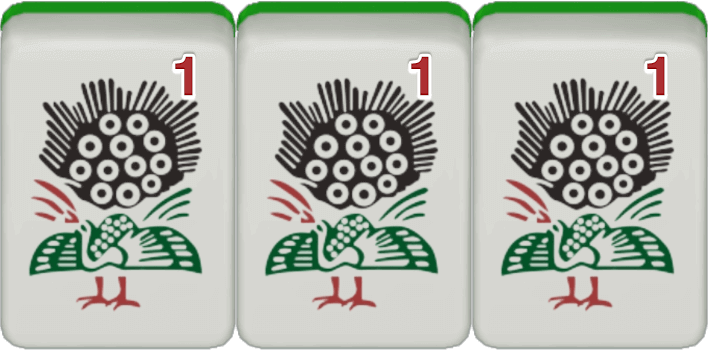Pung of Terminals or Honors
What Is Pung of Terminals or Honors
Pung of Terminals or Honors is a one-fan pattern in Chinese Mahjong that requires making a three-of-a-kind out of 1’s, 9’s, or honor tiles. Each qualifying pung can add +1 fan, making it an appealing bonus to incorporate into chow-less or pung-heavy hands.
- Terminals: The “1” and “9” tiles in the three suits (Craks, Bams, Dots).
- Honors: The four wind tiles (East, South, West, North) and the three dragon tiles (Red, Green, White).
The Tile Pattern of Pung of Terminals or Honors

Three of a Kind: You need a pung (three identical tiles). In Chinese Mahjong, a pung can be formed in two ways:
- Concealed: By drawing all three matching tiles yourself.
- Melded: By claiming someone else’s discard to complete the triplet.
Terminals or Honors Only: Each qualifying pung must be composed of either terminal tiles (1 or 9 in Craks, Bams, Dots) or honor tiles (winds/dragons).
Examples:
- 1 of Craks ×3
- 9 of Bams ×3
- Red Dragon ×3
- East Wind ×3
Multiple Instances: Each distinct pung of terminals/honors can count toward the pattern. Depending on local or tournament rules about stacking or repeated patterns, you might get +1 fan for each pung of terminals or honors you hold in the final hand.
Fan Value of Pung of Terminals or Honors
In Chinese Mahjong scoring, Pung of Terminals or Honors is worth 1 fan per distinct qualifying pung. If your final hand includes multiple such pungs (e.g., a pung of East Wind and a pung of 9 of Dots), you might earn multiple instances of the bonus—subject to rules about repeated patterns.
Strategies and Considerations of Pung of Terminals or Honors
Keeping Terminals and Honors: In many Mahjong variants, terminals (1’s and 9’s) and honors (winds, dragons) can be more challenging to use, since they do not form chows (sequences). However, if you see you are accumulating a pair or two of these tiles, you might decide to go for a pung of terminals/honors for the extra fan.
Pairing with “All Pungs” or “Half Flush/Full Flush”
- A hand that aims for All Pungs can easily incorporate one or more pungs of terminals/honors.
- If your hand is trending toward a single suit plus honors or purely one suit , keep an eye out for potential terminal/honor pungs that boost your fan count.
Awareness of Rounds and Seats: Honor tiles might be valuable to your opponents—especially if they correspond to the current round wind or someone’s seat wind. They may try to pung them for bigger points (e.g., for a wind pung worth more fan under certain rules). Keep track of which honors people are likely holding.
Monitoring Discards: If you notice multiple copies of a specific terminal/honor in other players’ discard piles, forming a pung of that tile may be impossible. Switch strategies if your needed tiles are all gone.
Risk of Holding Honors: Many opponents discard honors early if they don’t need them, to avoid giving others a pung. Think carefully about whether you want to keep honors in your hand if you see them flooding the discard pool.
Caution:
- Low Flexibility: Terminal and honor tiles cannot form chows, which reduces your hand’s flexibility in forming sequences. Only consider collecting them if you have a clear path or synergy toward pungs.
- Overcommitting: While each pung of terminals/honors yields +1 fan, forcing too many terminal/honor pungs might slow your hand development and cause you to miss faster or more lucrative patterns.
LEARN
TOOLS
